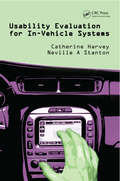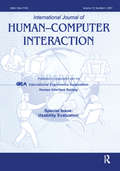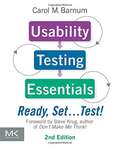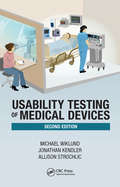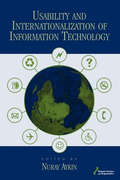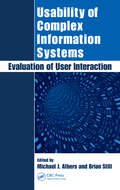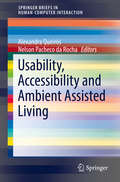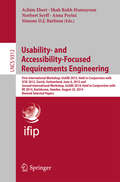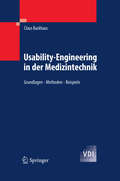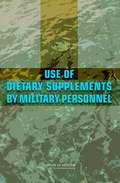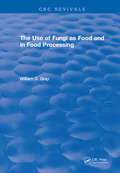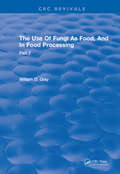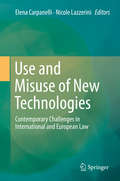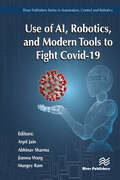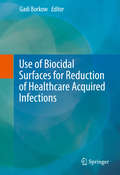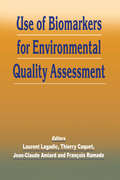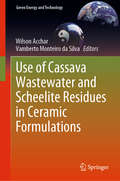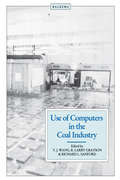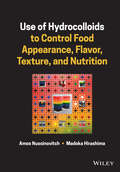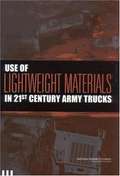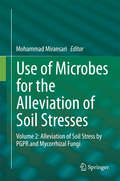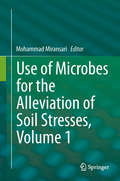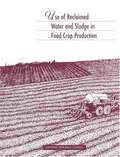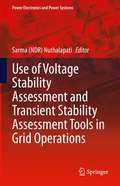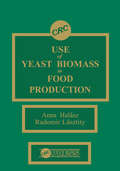- Table View
- List View
Usability Evaluation for In-Vehicle Systems
by Catherine Harvey Neville A. StantonErgonomics often seems to be involved too late in commercial project development processes to have substantive impact on design and usability. However, in the automotive industry, and specifically in relation to In-Vehicle Information Systems (IVIS), a lack of attention to usability can not only lead to poor customer satisfaction, it can also present problems. This book presents a process which will support the evaluation and modeling of driver-interface interactions in a dual-task driving context. This process consists of a framework of methods which can be used to evaluate and model the usability of In-Vehicle information Systems (IVIS). The book's focus on design and evaluation of IVIS, coupled with a systems approach to the concept of usability, sets it apart. This method presents both an autopsy and diagnostic approach to investigating usability in IVIS.
Usability Evaluation: A Special Issue of the International Journal of Human-Computer Interaction
by James R. LewisVolume 14, Number 1, 2002. Contents: J.R. Lewis, Introduction. ARTICLES: D.J. Gillan, R.G. Bias, Usability Science 1: Foundation. H.R. Hartson, T.S. Andre, R.C. Williges, Criteria for Evaluating Usability Evaluation Methods. R.E. Cordes, Task Selection Bias: A Case for User-Defined Tasks. M. Hertzum, N.E. Jacobsen, The Evaluator Effect: A Chilling Fact About Usability Evaluation Methods. J.R. Lewis, Evaluation of Procedures for Adjusting Problem-Discovery Rates Estimated From Small Samples. M. Hassenzahl, The Effect of Perceived Hedonic Quality on Product Appealingness.
Usability Testing Essentials: Ready, Set ...Test!: Ready, Set...Test!
by Carol M. BarnumUsability Testing Essentials presents a practical, step-by-step approach to learning the entire process of planning and conducting a usability test. It explains how to analyze and apply the results and what to do when confronted with budgetary and time restrictions. This is the ideal book for anyone involved in usability or user-centered design―from students to seasoned professionals. Filled with new examples and case studies, Usability Testing Essentials, Second Edition is completely updated to reflect the latest approaches, tools and techniques needed to begin usability testing or to advance in this area. Provides a comprehensive, step-by-step guide to usability testing, a crucial part of every product’s development Discusses important usability issues such as international testing, persona creation, remote testing, and accessibility Presents new examples covering mobile devices and apps, websites, web applications, software, and more Includes strategies for using tools for moderated and unmoderated testing, expanded content on task analysis, and on analyzing and reporting results
Usability Testing of Medical Devices
by Michael E. Wiklund P.E. Jonathan Kendler Allison Y. StrochlicUsability Testing of Medical Devices covers the nitty-gritty of usability test planning, conducting, and results reporting. The book also discusses the government regulations and industry standards that motivate many medical device manufacturers to conduct usability tests.Since publication of the first edition, the FDA and other regulatory groups h
Usability and Internationalization of Information Technology (Human Factors and Ergonomics)
by Nuray AykinToday, more and more Web sites are providing content in multiple languages for targeted countries, and more and more products are being designed for cultural differences in mind. However, the concept of cross-cultural design has not yet become a strong force in the practitioners' and educators' agenda. This book looks at techniques, software, tools
Usability of Complex Information Systems: Evaluation of User Interaction
by Michael J. Albers Brian StillWhy do enterprise systems have complicated search pages, when Google has a single search box that works better? Why struggle with an expense reimbursement system that is not as easy as home accounting software? Although this seems like comparing apples to oranges, as information and communication technologies increasingly reach into every industry
Usability, Accessibility and Ambient Assisted Living
by Alexandra Queirós Nelson Pacheco da RochaWorldwide, the population ageing is a reality. The concept of Active Ageing, adopted by the World Health Organization, aims to guarantee quality ageing and appears as a strategy to solve this demographic challenge. The technological solutions might have a key role in the promotion of human functioning and in the mitigation of disabilities, particularly those resulting from the natural ageing process. This perspective is evident in the development of Ambient Assisted Living (AAL) solutions. In this context, it is relevant to know about the recent developments in AAL and discuss future trends and challenges in this area. One of the objectives of this book is to do a systematic literature review on AAL, not only considering the technology used, but also the health condition that is intended to improve. For this purpose, we consider the human functioning, in particular the conceptual model of International Classification of Functioning, Disability and Health (ICF). Considering that the ICF conceptual framework is accepted within the healthcare domain, the use of its concepts and terminologies to promote multidisciplinary approaches for AAL solutions development processes can help to overcome difficulties of communication between users, careers and technological developers. AAL solutions must consider in their development the needs of the person that will use AAL solutions. The development must be user-centred and usability questions cannot be forgotten. In addition, the acceptance of the AAL solutions is closely related to the quality of the systems, so it is necessary to appropriately assess these solutions.
Usability- and Accessibility-Focused Requirements Engineering
by Achim Ebert Shah Rukh Humayoun Norbert Seyff Anna Perini Simone D. J. BarbosaThis book constitutes the thoroughly refereed post-conference proceedings of theFirst International Workshop on Usability and Accessibility focused RequirementsEngineering, UsARE 2012, held in Zurich, Switzerland, in June 2012 in conjunctionwith ICSE 2012, the 34th International Conference on Software Engineering, and theSecond International Workshop, UsARE 2014, held in Karlskrona, Sweden, in August2014, in the course of RE 2014, the 22nd International Requirements EngineeringConference. This book consists of 10 chapters of which 9 are extended versions of the paperspresented at the two UsARE events. Amongst them, 3 are extended versions of thepapers presented at UsARE 2012 and 6 are extended versions of papers presented atUsARE 2014 - rounded off by a new chapter that was added as authors are doingrelevant work on the same topic. The chapters are organized into three sectionsaccording to their main focus: usability and user experience, accessibility andapplications.
Usability-Engineering in der Medizintechnik
by Claus BackhausErgonomisch gestaltete Medizintechnik führt zu effizienteren Arbeitsabläufen, erhöht die Patientensicherheit und reduziert die Arbeitsbelastung. Das Buch erläutert, wie Medizintechnik an die Bedürfnisse der Nutzer und Anwender angepasst werden kann. Durch das beschriebene Vorgehen ist es möglich, sowohl die Anforderungen der harmonisierten Normen DIN EN 62366 und DIN EN 60601-1-6 umzusetzen als auch neue Lösungsansätze für die Entwicklung innovativer Medizintechnik zu erarbeiten. Die Umsetzung wird anhand ausgewählter Praxisbeispiele erörtert.
Use Of Dietary Supplements By Military Personnel
by Institute of Medicine of the National AcademiesDietary supplements are widely available through a rapidly expanding market of products commonly advertised as beneficial for health, performance enhancement, and disease prevention. Given the importance and frequent evaluation of physical performance and health as a criteria to join and remain in the military, the use of these products by military personnel has raised concern regarding over-all and long-term efficacy and safety. This evaluation is especially difficult, as many of these supplements contain multiple ingredients, have a changing composition over time, or are used intermittently at doses difficult to measure. This book analyzes the patterns of dietary supplement use among military personnel, examines published reviews of the scientific evidence, and identifies those dietary supplements that are beneficial and/or warrant concern due to risks to health or performance. The book also recommends a system to monitor adverse health effects and a framework to identify the need for active management of dietary supplements by military personnel. Military policy makers, personnel, and recruits will find this book useful, as will nutritionists, athletes, and others working in strenuous environments.
Use Of Fungi As Food: Volume 1 (Crc Monoscience Ser.)
by William D GrayThe present work is an attempt to bring together in some sort of organized form all such information that would link mycology (other than the involvement of fungi in food spoilage) to the food industry. It may be justly criticized for its brevity and, in some instances, will probably be criticized the philosophy expressed. For this the writer makes no apologies. In the first instance, the present discussion is by no means intended to be an exhaustive treatment of the subject. On the contrary, if it serves in some small measure to alert the student to the vast potential resident in fungi, its purpose will have been served.
Use Of Fungi As Food: Volume 2
by Dave GrayFew laymen are aware that cookbooks devoted solely to the preparation of mushrooms exist. This fact is brought to their attention and a few recipes are presented in detail. No attempt is made to exhaust the subject but as in the remainder of the book, enough is presented to give a view of the potential and the reader is directed to the relevant literature so that he can pursue the subject in greater depth if he chooses.
Use and Misuse of New Technologies: Contemporary Challenges in International and European Law
by Elena Carpanelli Nicole LazzeriniThe ever-increasing use of technology is challenging the current status of the law, bringing about new problems and questions. The book addresses this trend from the perspective of International law and European Union law and is divided into three main thematic sections. The first section focuses on the legal implications of the use of technology either for law enforcement purposes or in the context of military activities, and examines how this use adds a new dimension to perennial issues, such as the uneasy balance between security concerns and the protection of individual rights, and defining the exact scope of certain State obligations. In so doing, it takes into account a range of current and potential scenarios at the international, regional and domestic level, including the use of killer robots, databases, drones and technology in general to patrol borders, exchange information on criminal suspects, maintain public order, target suspected terrorists and conduct military activities. In turn, the second section examines the role of institutional and non-institutional actors in establishing substantive normative standards for the use of high-tech applications. In this respect, it focuses both on the role that European courts have played so far, and on how other actors’ initiatives can contribute to the construction of a new legal framework for technology-related activities. Lastly, the third section has a two-fold focus: the first part investigates how the increasing reliance on technology is affecting traditional rules on international responsibility, and is challenging, in particular, the attribution of wrongful conduct to States and international organizations. The second part addresses issues of jurisdiction and justiciability. Given the scope of its coverage, this timely book addresses an important lacuna in the current legal scholarship, exploring some of the most recent applications of technology and the legal issues arising as a result. Readers will gain novel insights into the challenges posed to International law and European law by the growing reliance on technology, taking into account both its uses and misuses.
Use of AI, Robotics and Modelling tools to fight Covid-19
by Mangey Ram Abhinav Sharma Arpit Jain Jianwu WangThe COVID-19 pandemic has hit the global at a colossal scale. With worldwide reported cases of 5.34 million it has led to severe impact on humanity. Being a highly contagious disease, it has given global health services their most severe challenge. Various countries are fighting to minimize the losses due to the outbreak, however a common trait is enforcing lockdown, which has become the main defence mechanism. Researchers are working around the clock to find a breakthrough in the diagnostics and treatment of the pandemic.AI technology is useful for fast drug development and treatment. In the starting phase of COVID-19 pandemic, the medical fraternity in China diagnosed the virus using computed tomography (CT) and X-ray images due to the limitation of testing kits. Deep learning neural network model have also been used for COVID-19 diagnosis. AI assisted intelligent humanoid robots can be used to reduce the human contact and spread of COVID-19. In Italy robots have been used for measuring blood pressure, oxygen saturation and temperature of patients. Robots have also found applications in disinfecting and sterilizing of public places, COVID-19 testing, food and medicine delivery as well as entertaining patients in hospitals and quarantine centers, thereby reducing the workload of doctors and nurses.Prediction of the spread of virus and providing the guidelines or prevention measures is another AI application in COVID-19. Kaggle and GitHub are the two websites where the real-time data of COVID-19 is aggregated. This includes confirmed cases, active cases, cured cases and deaths in each country. This data set can be used for predicting the active cases across different regions of the world so that appropriate amount of health infrastructure can be made available to these places.
Use of Biocidal Surfaces for Reduction of Healthcare Acquired Infections
by Gadi BorkowThe notion that contaminated environments in hospital settings significantly contribute to the risk of an individual acquiring an infection while hospitalized is continuously gaining recognition by the medical community. There is a clear correlation between the environmental bioburden present in a clinical setting and the risk of patients acquiring an infection. Thus using self-disinfecting surfaces can be a very important adjunct in the fight against nosocomial pathogens. This book reviews the increasing evidence that contaminated non-intrusive soft and hard surfaces located in the clinical surroundings are a source of nosocomial pathogens and focuses on the utility of copper containing materials in reducing bioburden and fighting hospital acquired infections. It also reviews other biocidal surface alternatives and the economics of using biocidal surfaces in a hospital environment. Finally, it discusses the pros and cons of existent disinfection modalities other than biocidal surfaces.
Use of Biomarkers for Environmental Quality Assessment
by Jean-Claude Amiard Thierry Caquet Laurent LagadicThis work is primarily designed for any person or organization in charge of assessment of the quality of natural resources and of pollution prevention.
Use of Cassava Wastewater and Scheelite Residues in Ceramic Formulations (Green Energy and Technology)
by Wilson Acchar Vamberto Monteiro da SilvaThis book presents original results on the use of cassava wastewater as a substitute for potable water in ceramic formulations. It evaluates the physical and mechanical properties as well as the microstructure of the materials produced, comparing the products obtained from the incorporating effluent with the conventional materials used in the construction industry.
Use of Computers in the Coal Industry 1986
by Y.J. Wang, R. Larry Grayson and Richard L. SanfordThis book is an outcome of the third conference on the use of computers in the coal industry in Morgantown. It presents valuable computer applications covering the most aspects of coal industry and covers following areas: mine management and economics; surface mining; coal preparation; and blasting.
Use of Hydrocolloids to Control Food Appearance, Flavor, Texture, and Nutrition
by Amos Nussinovitch Madoka HirashimaUse of Hydrocolloids to Control Food Appearance, Flavor, Texture, and Nutrition A thoroughly up-to-date and forward-looking presentation of the use of hydrocolloids in food In Use of Hydrocolloids to Control Food Appearance, Flavor, Texture, and Nutrition, a team of distinguished food researchers combines comprehensive and authoritative discussions on the conventional use of hydrocolloids to influence shape, structure and organoleptic properties of foods with exciting and emerging areas of innovation, such as texturing for 3D printing and enhancement of food nutrition. The book explores the four principal quality factors of food: appearance, flavor, texture and nutrition, and introduces students and food technologists to the myriad uses of hydrocolloids. It also presents illustrations of relevant commercial food products that rely on hydrocolloids for their appeal, as well as recipes exemplifying the unique abilities of particular hydrocolloids. Readers will also find: A thorough introduction to the use of hydrocolloids to control food size and shape, including the manipulation of select geometrical properties of foods A comprehensive exploration of the use of hydrocolloids to modulate food color and gloss, including the psychological impact of those properties Practical discussions pertaining to the modification of food taste and odor using hydrocolloids A thorough description of the ways in which hydrocolloids are used to improve crispy, crunchy and crackly foods Perfect for food scientists working in product development and food engineers, Use of Hydrocolloids to Control Food Appearance, Flavor, Texture, and Nutrition is sure to earn a place in the libraries of research chefs, as well as food chemists, food microbiologists and food technologists.
Use of Lightweight Materials in 21st Century Army Trucks
by National Resource CouncilIn order to achieve the Army's envisioned Objective Force related to deployability, transportability, and mobility, the Committee on Lightweight Materials for the 21st Century Army Trucks was asked to identify research and technology development opportunities related to the introduction of new lightweight structural materials for light, medium and heavy Army trucks.
Use of Microbes for the Alleviation of Soil Stresses
by Mohammad MiransariUse of Microbes for the Alleviation of Soil Stresses, Volume 2: Alleviation of Soil Stress by PGPR and Mycorrhizal Fungi describes the most important details and advances related to the alleviation of soil stresses by PGPR and mycorrhizal fungi. Comprised of eleven chapters, the book reviews the role of arbuscular mycorrhizal fungi in alleviation of salt stress, the role of AM fungi in alleviating drought stress in plants, the impact of biotic and abiotic stressors and the use of mycorrhizal fungi to alleviate compaction stress on plant growth. Written by experts in their respective fields, Use of Microbes for the Alleviation of Soil Stresses, Volume 2: Alleviation of Soil Stress by PGPR and Mycorrhizal Fungi is a comprehensive and valuable resource for researchers and students interested in the field of microbiology and soil stresses.
Use of Microbes for the Alleviation of Soil Stresses, Volume 1
by Mohammad MiransariUse of Microbes for the Alleviation of Soil Stresses, Volume 1 describes the most important details and advances related to the alleviation of soil stresses by soil microbes. Comprised of seven chapters, the book reviews the mechanisms by which plant growth promoting rhizobacteria (PGPR) alleviate plant growth under stress; the role of mycorrhizal fungi on the alleviation of drought stress in host plants; how PGPR may alleviate salinity stress on the growth of host plants; and the role of PGPR on the growth of the host plant under the stress of sub optimal root zone temperature. Written by experts in their respective fields, Use of Microbes for the Alleviation of Soil Stresses, Volume 1 is a comprehensive and valuable resource for researchers and students interested in the field of microbiology and soil stresses.
Use of Reclaimed Water and Sludge in Food Crop Production
by Committee on the Use of Treated Municipal Wastewater Effluents Sludge in the Production of Crops for Human ConsumptionThis book reviews the practice of reclaiming treated municipal wastewater for agricultural irrigation and using sewage sludge as a soil amendment and fertilizer in the United States. It describes and evaluates treatment technologies and practices; effects on soils, crop production, and ground water; public health concerns from pathogens and toxic chemicals; existing regulations and guidelines; and some of the economic, liability, and institutional issues. The recommendations and findings are aimed at authorities at the federal, state, and local levels, public utilities, and the food processing industry.
Use of Voltage Stability Assessment and Transient Stability Assessment Tools in Grid Operations (Power Electronics and Power Systems)
by Sarma Ndr NuthalapatiThis book brings together real-world accounts of using voltage stability assessment (VSA) and transient stability assessment (TSA) tools for grid management. Chapters are written by leading experts in the field who have used these tools to manage their grids and can provide readers with a unique and international perspective. Case studies and success stories are presented by those who have used these tools in the field, making this book a useful reference for different utilities worldwide that are looking into implementing these tools, as well as students and practicing engineers who are interested in learning the real-time applications of VSA and TSA for grid operation.
Use of Yeast Biomass in Food Production
by Radomir Lasztity Anna HalaszYeast biomass is an excellent source of proteins, nucleic acids, and vitamins. It has been produced and consumed in baked goods and other foods for thousands of years and offers significant advantages when compared to other potential new microbial protein sources. Use of Yeast Biomass in Food Production provides up-to-date information regarding the chemical composition and biochemistry of yeasts, discusses the biotechnological basis of yeast production and possibilities for influencing yeast biomass composition using new techniques in molecular biology. The book examines techniques for producing yeast protein concentrates (and isolates) while still retaining their functional properties and nutritive values, as well as the various uses for these materials and their derivatives in different branches of the food industry. Finally, the book explores possibilities for the production and industrial use of other yeast components, such as nucleic acids, nucleotides, cell wall polysaccharides, autolysates, and extracts. Food microbiologists and technologists, as well as biotechnologists, will discover that this book is an invaluable reference resource.
